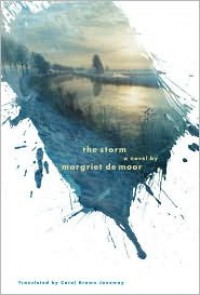3
Followers
25
Following
Iris on Books
Iris is a PhD student and book blogger who's favourite pastime is curling up under a blanket with a cup of tea and a good book.
Currently reading
Eight Days of Luke
Delusions of Gender: The Real Science behind Sex Differences
Yellowcake
An Abundance of Katherines
The Storm: A novel
 In The Storm, Margriet de Moor interweaves the stories of two sisters. One sister is called Lidy. She visits the birthday party of a little girl in a small village on Schouwen Duivenland. While Lidy visits this party, the entire region is flooded during the North Sea Flood of 1953. The other story is that of Lidy’s sister Armanda, who we follow over the course of the years following the flood. Armanda tries to cope with the grief over her sister going missing. She also tries to rebuild her life, marrying Lidy’s husband and taking care of Lidy’s daughter.
In The Storm, Margriet de Moor interweaves the stories of two sisters. One sister is called Lidy. She visits the birthday party of a little girl in a small village on Schouwen Duivenland. While Lidy visits this party, the entire region is flooded during the North Sea Flood of 1953. The other story is that of Lidy’s sister Armanda, who we follow over the course of the years following the flood. Armanda tries to cope with the grief over her sister going missing. She also tries to rebuild her life, marrying Lidy’s husband and taking care of Lidy’s daughter.I had planned to read a novel by Margriet de Moor for Dutch Lit Month in my effort to read a more balanced ratio of female to male authors. Initially, I was going to read First grey, then white, then blue which is her debut novel, but it appears to be out of print in English. By then, I had started coming across this stunning cover of The Storm over at Regular Rumination and Olduvai Reads. We all know how persuasive covers can be.. Another reason to decide on reading this one instead of De Moor’s debut was that, as a recently released translation, it was bound to be more readily available in English. Oh, and of course, the subject matter of The Storm did sound interesting as well.
I am definitely glad I read The Storm, as it has that emotional quality which means you will find yourself thinking about it for days after you have read it. Wondering about Lidy’s and Armanda’s lives.. Wondering about the “what ifs” and if there might have been any better (but probably also worse) alternatives.
I did find myself caring more about Lidy’s story than Armanda’s. Perhaps that is inevitable when a story that follows a person in an almost hour to hour ordeal is contrasted with one that follows a character over a number of years. The former allows a portrayal of each surge of hope and each devastating blow, while the latter can do the same, but only by providing glimpses of certain moments, which are then interspersed by long periods of time about which you learn nothing directly.
Nevertheless the shifting perspective does not lead to a division of the novel into two separate parts. Perhaps because in Lidy’s story there is a lot of reflection on her family, including Armanda. And Armanda’s story is caught up in the search for Lidy, and the grief over Lidy, as a missing person. This meant that while I found Lidy the more appealing character, I never found myself wishing for the parts in which Armanda’s story took precedence to be over. The novel remains a clearly defined whole, which is laudable as the shifts in perspective also mean shifts in setting and time.
The one difficulty I did have with The Storm was that it took quite some time to get used to De Moor’s prose. At first, I had to puzzle over some of the sentences, which can be quite long [look who's talking]. And it was only after 40 pages or so that I felt myself comfortably slide into the story. However, once I did, I did not want to stop reading.
[Review originally posted over at Iris on Books]






